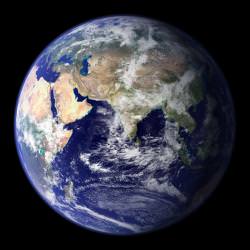NASA researchers have developed a new technique that gives them a precise measurement for the position of the centre of the Earth, to the closest millimetre. This is harder than it sounds, since the centre doesn’t stay in one position.
As the Earth rotates in space, its centre of mass ranges over a distance of 2 to 5 millimetres (.08 to .20 inches) a year. Until now, the best calculations differed by 1.8 millimetres a year. That doesn’t sound like much, but its actually important for very precise measurements. For example, the rise in global sea level due to increasing temperatures is measured in a handful millimetres. In other places, the Earth is rebounding after the weight of glaciers during the last ice age, 20,000 years ago.
The researchers combined 4 different space-based techniques to get this accurate measurement: the global positioning system, laser stations that track orbiting satellites, radio telescopes that measure the position of the Earth against quasars, and a French network of tracking satellites called DORIS.
Original Source: NASA/JPL News Release


Is it really possible to locate the Earth’s centre of mass to that degree of accuracy? Surely the measurements made can only locate the geometrical centre as the Earth’s exterior dimensions can be measured reasonable accurately by satellite, but the Earth’s interior is in a state of flux. Doesn’t the present method used assume a uniform density (which of course is wrong)? Please explain.
Interesing stuff..